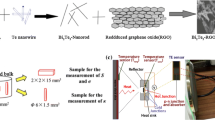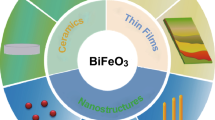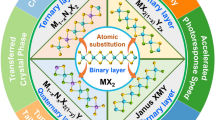Abstract
In the present work, the effects of Bi-Mg co-doping on the thermoelectric properties of SnTe materials are investigated. Pristine SnTe and Sn0.96Bi0.02Mg0.02Te materials are synthesized using a facile solvothermal technique. Calculated crystallite size and grain size decrease after Bi-Mg co-doping. In Sn0.96Bi0.02Mg0.02Te various lattice defects, lattice strain, stacking fault and dislocation densities are higher as compared to pristine SnTe. Minimum lattice thermal conductivity is 0.21 W/mK in Sn0.96Bi0.02Mg0.02Te and 1.13 W/mK in pristine SnTe at 584 K. Lower lattice thermal conductivity in Bi-Mg co-doped SnTe may be due to more phonon scattering at interfaces and lattice defects. A decrease in carrier concentration following doping may lead to a decrease in electrical conductivity in Sn0.96Bi0.02Mg0.02Te as compared to SnTe. Maximum S in Sn0.96Bi0.02Mg0.02Te is 72 μV/K and in pure SnTe is 66 μV/K at 584 K. The increase in S may be due to band engineering via Bi-Mg co-doping as (i) Bi generates resonant energy states at the Fermi level of SnTe (ii) Mg doping modifies the band structure of SnTe via converging valence bands and widening the band gap. Maximum ‘figure of merit’ zT = 0.21 in Sn0.96Bi0.02Mg0.02Te is 91% higher than pristine SnTe at 584 K. Material quality factor (B = BET/κL) indicates that maximum zT > 1 can be achieved until S = 246 μV/K in Sn0.96Bi0.02Mg0.02Te. The electronic contribution of quality factor falls after doping which demonstrates that the increase in zT is caused by a decrease in lattice thermal conductivity. The thermoelectric efficiency and figure of merit ‘ZT’ of thermoelectric devices composed of Sn0.96Bi0.02Mg0.02Te are almost double those of pristine SnTe. Thus experimental findings reveal that Bi-Mg co-doped SnTe can be a potential thermoelectric material.













Similar content being viewed by others
Data Availability
Data will be made available on request.
Abbreviations
- S:
-
Seebeck coefficient
- σ:
-
Electrical conductivity:a,b,c:Lattice cell parameters
- S 2 σ :
-
Power factor
- ĸ :
-
Thermal conductivity
- κ e :
-
Electronic thermal conductivity
- κ e :
-
Lattice thermal conductivity
- z :
-
Ioffe’s figure of merit
- zT :
-
Figure of merit of a material
- T :
-
Absolute temperature
- ZT:
-
The figure of merit of thermoelectric device
- kB :
-
Boltzmann constant
- L:
-
Lorenz number
- EF :
-
Fermi level
- D:
-
Crystallite size
- e:
-
Electronic charge
- h:
-
Planck’s constant
- υ:
-
Frequency
References
A.F. Ioffe, Semiconductor thermoelements, and thermoelectric cooling (Infosearch, London, 1957)
F.P. Incropera, D.P. Dewitt, T.L. Bergman, A.S. Lavine, Fundamentals of Heat and Mass Transfer (John Wiley, Hoboken, 2007)
M. Noroozi, G. Jayakumar, K. Zahmatkesh, J. Lu, L. Hultman, M. Mensi, S. Marcinkevicius, B. Hamawandi, M.Y. Tafti, A.B. Ergul, Z. Ikonic, M.S. Toprak, H.H. Radamson, Unprecedented thermoelectric power factor in SiGe nanowiresfield-effect transistors. ECS J. Solid State Sci. Technol. 6(9), Q114–Q119 (2017)
K. Biswas, J. He, I.D. Blum, C.-I. Wu, T.P. Hogan, D.N. Seidman, V.P. Dravid, M.G. Kanatzidiz, High-performance bulk thermoelectrics with all-scale hierarchical architectures. Nature 489, 414 (2012)
R. Moshwan, L. Yang, J. Zou, Z.-G. Chen, Eco-friendly SnTe thermoelectric materials: progress and future challenges. Adv. Func. Mater. 27(43), 1703278 (2017)
R.F. Brebrick, A.J. Strauss, Anomalous thermoelectric power as evidence for two-valence bands in SnTe. Phys. Rev. 131(1), 104–110 (1963)
A. Bugalia, V. Gupta, N. Thakur, Strategies to enhance performance of thermoelectric materials: a Review. J. Renew. Sustain. Energy 15, 032704 (2023)
S. Acharya, J. Pandey, A. Soni, Soft Phonon modes driven reduced thermal conductivity in self-compensated Sn1.03Te with Mn doping. Appl. Phys. Lett. 109, 133904 (2016)
Q. Long, J. Xin, S. Li, A. Basit, Tuning the thermoelectric performance of SnTe via dual-site electronic donation and super-saturation solution. ACS Appl. Energy Mater. 2, 7490–7496 (2019)
Z. Zhou, J. Yang, Q. Jiang, Y. Luo, D. Zhang, Y. Ren, X. He, J. Xin, Multiple effect of Bi doping to enhanced thermoelectric properties of SnTe. J. Mater. Chem. A. 4, 13171–13175 (2016)
A. Banik, B. Vishal, S. Perumal, R. Datta, K. Biswas, The origin of low thermal conductivity in Sn1-xSbxTe: phonon scattering via layered intergrowth nanostructures. Energy Environ. Sci. 9, 2011–2019 (2016)
Q. Zhang, B. Liao, Y. Lan, Z. Ren, High thermoelectric performance by resonant dopant Indium in nanostructured SnTe. Proc. Natl. Acad. Sci. 110(3), 13261–13266 (2013)
D.K. Bhat, U.S. Shenoy, Zn: A versatile resonant dopant for SnTe thermoelectrics. Mater. Today Phys. 11, 100158 (2019)
T. Hussain, X. Li, M.H. Danish, M.U. Rehman, J. Zhang, D. Li, G. Chen, G. Tang, Realizing high thermoelectric performance in eco-friendly SnTe via synergistic resonance levels, band convergence and endotaxial nanostructuring with Cu2Te. Nano Energy 73, 104832 (2020)
A. Banik, U.S. Shenoy, S. Anand, U. Waghmare, Mg alloying in SnTe facilitates valence band convergence and optimizes thermoelectric properties. Chem. Mater. 27(2), 581–587 (2015)
G. Tan, F. Shi, J.W. Doak, H. Sun, L.-D. Zhao, P. Wang, C. Uher, C. Wolverten, V.P. Dravid, M.G. Kanatzidis, Extraordinary role of Hg in enhancing the thermoelectric performance of p-type SnTe. Energy Environ. Sci. 8, 267 (2015)
X.J. Tan, H.Z. Shao, J. He, G.Q. Liu, J.T. Xu, J. Jiang, H.C. Jiang, Band engineering and improved thermoelectric performance in M-doped SnTe (M=Mg, Mn, Cd and Hg). Phys. Chem. Chem. Phys. 18, 7141–7147 (2016)
R.A.R.A. Qrabi, N. Mecholsky, J. Hwang, W. Kim, Band degeneracy, low thermal conductivity and high thermoelectric figure of merit in SnTe-CaTe alloys. Chem. Mater. 28(1), 376–384 (2015)
F. Guo, B. Cui, Y. Liu, X. Meng, Thermoelectric SnTe with band convergence, dense dislocations, and interstitials through Sn self-compensation and Mn alloying. Small 14(37), 1802615 (2018)
Y. Pei, L. Zheng, W. Li, S. Lin, Interstitial point defect scattering contributing to high thermoelectric performance in SnTe. Adv. Electron. Mater. 2, 1600019 (2016)
L. Wang, X. Tang, G. Liu, H. Shao, B. Yu, H. Jiang, S. Tue, J. Jiang, Manipulating band convergence and resonant state in thermoelectric material SnTe by Mn-In co-doping. ACS Energy Lett. 2, 1203–1207 (2017)
D.K. Bhat, U.S. Shenoy, High thermoelectric properties of co-doped Tin Telluride due to synergistic effect of Magnesium and Indium. J. Phys. Chem. C 121(13), 7123–7130 (2017)
D.K. Bhat, U.S. Shenoy, Enhanced thermoelectric performance of bulk tin telluride: Synergistic effect of calcium and indium co-doping. Mater. Today Phys. 4, 12–18 (2018)
Q. Zhang, X. Tan, Z. Guo, H. Wang, C. Xiong, N. Man, F. Shi, H. Hu, G.-Q. Liu, J. Jiang, Improvement of thermoelectric properties of SnTe by Mn-Bi codoping. Chem. Eng. J. 42(2), 127795 (2021)
D.K. Bhat, U.S. Shenoy, Electronic structure engineering of tin telluride through co-doping of bismuth and Indium for high performance thermoelectrics: a synergistic effect leading to record high room temperature ZT in tin telluride. J. Mater. Chem. C. 7, 4817–4821 (2019)
J.R. Sootsman, D.Y. Chung, M.G. Kanatzidis, New and old concepts in thermoelectric materials. Angew. Chem. Int. Ed. 48, 8616–8639 (2012)
M.G. Kanatzidis, Nanostructutred thermoelectrics: A new paradigm? Chem. Mater. 22, 648–659 (2009)
L.D. Zhao, X. Zhang, H. Wu, G. Tan, Y. Pei, Y. Xiao, C. Chang, D. Wu, H. Chi, L. Zheng, S. Gong, C. Uher, J. He, M.G. Kanatzidis, Enhanced thermoelectric properties in the counter-doped snte system with strained endotaxial SrTe. J. Am. Chem. Soc. 138, 2366–2373 (2016)
T. Gangjian, L. Zhao, F. Shi, J. Doak, S.-H. Lo, H. Sun, C. Wolverton, V. Dravid, C. Uher, M.G. Kanatzidis, High thermoelectric performance of p-type SnTe via a synergistic band engineering and nanostructuring approach. J. Am. Chem. Soc. 136, 7006–7017 (2014)
X. Qi, Y. Huang, D. Wu, B. Jiang, B. Zhu, X. Xu, J. Feng, B. Jia, Z. Shu, J. He, Eutectoid nano-precipitations inducing remarkably enhanced ther moelectric performance in (Sn1-xCdxTe)1-y(Cu2Te)y. J. Mater. Chem. A. 8, 2798–2808 (2020)
B. Mason, The determination of the density of solids. Geol. Foeren. Stockholm Foerh. 66, 27–51 (1944)
S. Sk, A. Pandey, S.K. Pandey, Instrument for simultaneous measurement of Seebeck coefficient and thermal conductivity in the 300–800 K temperature range with python interfacing. Rev. Sci. Instrum. 93(4), 043902 (2022)
S. Singh, S.K. Pandey, Fabrication of simple apparatus for resistivity measurement in high temperature range 300–620 K. IEEE Trans. Instrum. Meas.. 67, 2169 (2017)
V. Anita, Gupta, improvement in structural properties of SnTe by Co doping for thermoelectric applications. Mater. Today: Proc. 46, 5857–5860 (2021)
K. Rani, V. Gupta, Ranjeet, surfactant assisted solvothermal synthesis of nanostructure for thermoelectric applications. Mater. Today Proc. 62, 6432–6437 (2022)
K. Rani, V. Gupta, V. Ranjeet, A. Pandey, Improved thermoelectric performance of Se doped n-type nanostructured Bi2Te3. J. Mater. Sci.: Mater Electron. 34(13), 1074 (2023). https://doi.org/10.1007/s10854-023-10490-y
V. Kavita, Gupta, Ranjeet, structural and morphological properties of nanostructured Bi2Te3 with Mn-doping for thermoelectric applications. Mater. Today Proc. 54, 820–826 (2022)
P. Scherrer, Bestimmung der grosse und der inneren struktur von kolloidteilchen mittels rontgenstrahlen. Nachr. Ges. Wiss. Gottingen. 26, 98 (1918)
J.I. Langford, A.J.C. Wilson, Scherrer after 60 Y: a survey and some new results in the determinatoon of crystallite size. J. Appl. Cryst. 11, 102 (1978)
V. Gupta, Defect engineering in Te rich SnTe for thermoelectric applications. Mater. Today Proc. 54, 637–641 (2022)
V. Gupta, Structural and morphological studies of Se doped SnTe thermoelectric materials. Mater. Today Proc. 62, 6420–6424 (2022)
D. Nath, F. Singh, R. Das, X-ray diffraction analysis by Williamson-Hall, Halder-Wagner and size-strain plot methods of CdSe nanoparticles- a comparative study. Mater. Chem. Phys. 239, 122021 (2020)
M.C. Robert, R. Saravanan, Single crystal X-ray analysis of electronic structure of the thermoelectric material Sn1-xGexTe. Indian J. Phys. 84(9), 1203–1210 (2010)
G. Chen, Size and interface effects on thermal conductivity and superlattices and periodic thin film structures. J. Heat Transfer. 119(2), 220–229 (1997)
P. Makula, M. Pacia, W. Macyk, How to Correctly Determine the Band Gap Energy of Modified Semiconductor Photocatalysts Based on UV–Vis Spectra. J. Phys. Chem. Lett. 9, 6814–6817 (2018)
A. Bugalia, V. Gupta, Structural, morphological and spectroscopic studies of Bi-Ca co-doped SnTe. J. Mater. Sci.: Mater. Electron. 34, 2190 (2023)
Z. Chen et al., Band engineering and precipitation enhance thermoelectric performance of SnTe with Zn-doping. Chinese Phys. B. 27, 047202 (2018)
A. Bugalia, V. Gupta, A. Pandey, Improvement in thermoelectric properties of Zn-Mn co-doped nanostructured SnTe through band engineering and chemical bond softening. J. Phys. D:Appl. Phys. 57, 195502 (2024)
G.S. Snyder, E.S. Toberer, Complex thermoelectric materials. Nat. Mater. 7, 105 (2008)
N. F. Mott, The Theory of Properties of Metals and Alloys (Dover Publications New York 1958)
C. Kittel, Introduction to Solid State Physics (Wiley, New York, 2005)
H.-S. Kim, Z.M. Gibbs, Y. Tang, H. Wang, G.J. Snyder, Characterization of Lorenz number with Seebeck coefficient measurement. APL Mater. 3, 041506 (2015)
S. Gaurav, S.K. Pandey, Efficiency calculation of a thermoelectric generator for investigating the applicability of various thermoelectric materials. J. Renew. Sustainale Energy 9, 014701 (2015)
B. Sherman, R.R. Heikes, R.W. Ure, Calculation of efficiency of thermoelectric devices. J. Appl. Phys. 31(1), 1–16 (1960)
G.J. Snyder, T.S. Ursell, Thermoelectric efficiency and compatibility. Phys. Rev. Lett. 91(14), 148301 (2003)
G.J. Snyder, A.H. Snyder, Figure of merit ZT of a thermoelectric device defined from materials properties. Energy Environ. Sci. 10, 2280–2283 (2017)
G.J. Snyder, T. Caillat, Using the compatibility factor to design high efficiency segmented thermoelectric generators. Mater. Res. Soc. Symp. Proc. 793, 37–42 (2003)
S.D. Kang, G.J. Snyder, Transport property analysis method for thermoelectric materials: material quality factor and the effective mass model. arXiv: Mater. Sci. (2017). https://doi.org/10.48550/arXiv.1710.06896
A. Zevalkink, D.M. Smiadak, J.L. Blackburn, A.J. Ferguson, M.L. Chabinyc, O. Delaire, J. Wang, K. Kovnir, J. Martin, L.T. Schelhas, T.D. Sparks, S.D. Kang, M.T. Dylla, G.J. Snyder, B.R. Ortiz, E.S. Toberer, A practical field guide to thermoelectrics: Fundamentals, synthesis, and characterization. Appl. Phys. Rev. 5(2), 021303 (2018)
X. Zhang, Z. Bu, X. Shi, Z. Chen, S. Lin, B. Shan, M. Wood, A.H. Snyder, L. Chen, G.J. Snyder, Y. Pei, Electronic quality factor for thermoelectrics. Sci. Adv. 6, eabc0726 (2020)
Acknowledgements
Authors acknowledge (i) Dr. Sudhir Kumar Pandey, School of Mechanical and Materials Engineering, Indian Institute of Technology Mandi, Kamand HP-175005 India for providing in-house developed facilities for thermoelectric measurements (ii) Material Research Centre, National Institute of Technology, Jaipur INDIA for Hall effect measurements.
Funding
No external funding was involved in the present research.
Author information
Authors and Affiliations
Contributions
Anita: Conceptualization, Investigation, Methodology, Formal Analysis, Writing – original draft. Vivek Gupta: Conceptualization, Methodology, Validation, Writing – review & editing, Supervision. Abhishek Pandey: Methodology, characterization, and validation.
Corresponding author
Ethics declarations
Competing interest
The authors declare that they have no known competing financial interests or personal relationships that could have appeared to influence the work reported in this paper.
Additional information
Publisher's Note
Springer Nature remains neutral with regard to jurisdictional claims in published maps and institutional affiliations.
Rights and permissions
Springer Nature or its licensor (e.g. a society or other partner) holds exclusive rights to this article under a publishing agreement with the author(s) or other rightsholder(s); author self-archiving of the accepted manuscript version of this article is solely governed by the terms of such publishing agreement and applicable law.
About this article
Cite this article
Anita, Gupta, V. & Pandey, A. Improvement in thermoelectric properties of Bi-Mg co-doped SnTe via band engineering and nanostructuring. J Mater Sci: Mater Electron 35, 617 (2024). https://doi.org/10.1007/s10854-024-12358-1
Received:
Accepted:
Published:
DOI: https://doi.org/10.1007/s10854-024-12358-1




